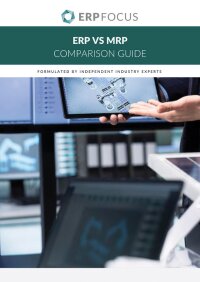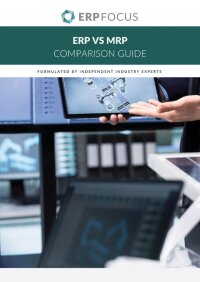ERP vs MRP: what is the difference?
Manufacturers and service organizations depend on integrated software to plan materials, resources, and budgets. Two systems born from the factory floor, MRP (Materials Requirements Planning) and ERP (Enterprise Resource Planning), share a lineage but solve different challenges.
MRP appeared in the 1970s to ensure shops ordered the right parts in the right quantities at the right time, cutting excess inventory and lowering costs. In the 1990s, software vendors expanded MRP’s planning core into full ERP suites, adding financials, CRM, HR, purchasing, sales, and marketing.
Today’s ERP platforms still include MRP as a module, but they also provide a centralized “single source of truth” across every department, avoiding the conflicting data silos that hamper growth.
What is the difference between ERP and MRP?
MRP focuses specifically on manufacturing execution (not to be confused with manufacturing execution systems): it takes a demand forecast or sales order (quantity + date), explodes the bill of materials to calculate required components, subtracts on‑hand inventory and open POs, and schedules purchase orders based on supplier lead times.
ERP covers a wide range of business functions, including financials, HR, CRM, procurement, supply chain, and analytics. It models material flows and resource planning, like people, machines, and facilities.
Target audience and implementation complexity
If your primary challenge is optimizing shop‑floor operations and raw‑material inventory, an MRP system may suffice. Many midsize manufacturers still rely on standalone MRP solutions that excel at materials planning and scheduling. However, if your organization requires cross‑department coordination, say, aligning purchasing budgets with forecasted revenue, or tying HR headcount plans to production ramp‑ups, you’ll benefit from a full‑featured ERP suite.
Deploying MRP alone typically demands a shorter timeline and smaller budget than rolling out a full ERP. You configure the material planning logic, map your Bill of Materials, and integrate with purchasing or finance as needed.
By contrast, ERP deployments can be phased, starting with financials and MRP, or undertaken all at once. While more resource‑intensive, a comprehensive ERP implementation pays dividends through unified reporting, standardized processes, and reduced manual workarounds.
What are the similarities between ERP and MRP?
Both systems share several foundational characteristics. They run on modern relational databases, support cloud‑based or on‑premises hosting, and provide dashboards and alerts that help businesses respond quickly to issues.
MRPs and ERPs can integrate with third‑party applications such as CAD software, e‑commerce platforms, or industry‑specific tools, and both can be customized to reflect unique workflows. Ultimately, whether you choose MRP or ERP, you gain visibility into operations, reduce errors, and improve capital utilization.
ERP vs MRP: Narrowing down your choices
- Define your requirements: List your must‑have and nice‑to‑have functions. If your needs center on shop‑floor scheduling and inventory control, a dedicated MRP may be enough.
- Evaluate growth potential: Consider whether you’ll need financial consolidation, multi‑site planning, or advanced analytics as you scale. If so, look for an ERP platform with a modular architecture. One that lets you add MRP, CRM, HR, or other suites as your business evolves.
- Assess vendor fit: Compare solution roadmaps, user‑community support, and industry expertise (consider manufacturing-specific ERP vendors, for instance). The right partner will guide your decision based on both present requirements and future aspirations.
Free white paper

ERP vs MRP comparison guide
Learn the key differences between ERP vs MRP. Includes real-world industry use cases.

Featured white papers
-

ERP vs MRP comparison guide
Learn the key differences between ERP vs MRP. Includes real-world industry use cases.
Download


